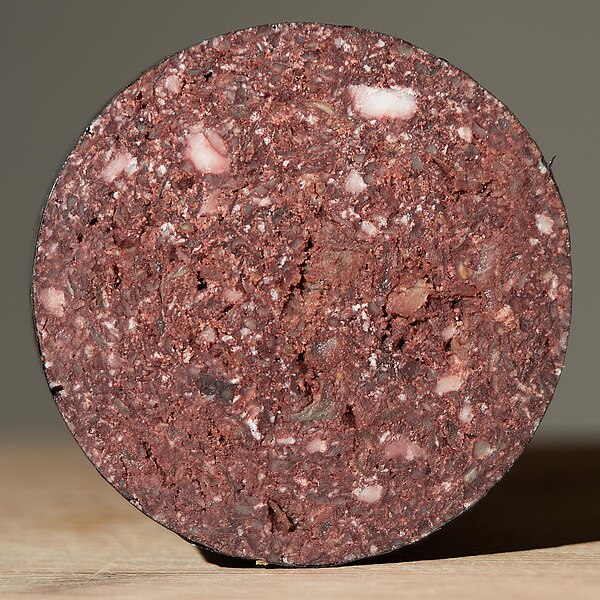Hello ladies and gents this is the Viking telling you that today we are talking about
BLACK PUDDING
Black pudding, also known as blood pudding, is a distinct regional type of blood sausage originating in the United Kingdom and Ireland. It is made from pork blood, with pork fat or beef suet, and a cereal, usually oatmeal, oat groats or barley groats. The high proportion of cereal, along with the use of certain herbs such as pennyroyal, serves to distinguish black pudding from blood sausages eaten in other parts of the world.
Etymology
The word pudding is believed to derive from the French boudin, originally from the Latin botellus, meaning "small sausage".
History and recipes
Blood puddings are often supposed to be one of the oldest forms of sausage. Animals are generally bled at slaughter, and as blood decays unless prepared in some way, making a pudding with it is one of the easiest ways of ensuring it does not go to waste.
While the majority of modern black pudding recipes involve pork blood, this has not always been the case. Sheep or cow blood was also used, and one 15th-century English recipe used that of a porpoise, in a pudding eaten exclusively by the nobility. Until at least the 19th century, cow or sheep blood was the usual basis for black puddings in Scotland; Jamieson's Scottish dictionary defined "black pudding" as "a pudding made of the blood of a cow or sheep".
As a product of the slaughtering process, eating black puddings was historically associated with Martinmas, when the annual slaughter of livestock took place. By the 19th century black pudding manufacture was linked with towns known for their large markets for pork, such as Stretford, then in Lancashire, or Cork, Ireland. By this time, black puddings were generally omitted from recipe books aimed at urban housewives, as they no longer usually had access to home-killed pork, although recipes would continue to appear in Scottish books until the 20th century.
Most traditional recipes from the UK involve stirring the fresh blood, adding fat and some form of rusk, and seasoning, before filling the mixture into a casing and boiling it. Natural casings of beef intestine were formerly used, though modern commercially made puddings use synthetic cellulose skins, and are usually produced from imported dried blood.
The relatively limited range of ingredients and use of oats or barley to thicken and absorb the blood is typical of black pudding in comparison to Continental blood sausages. Despite this, black pudding recipes still show more regional variation across the islands than other sausages, with many butchers having their own individual versions.
Breadcrumbs or flour are sometimes used to supplement the oats or barley, and the proportion and texture of the fat or suet used can also vary widely. Pennyroyal, marjoram, thyme, and mint are all traditional flavourings: pennyroyal was known as pudding-yerb in the North Riding of Yorkshire for its use in black puddings. Other herbs and spices sometimes used in traditional black puddings include cumin, rue and parsley.
While the dish has been known as black pudding for centuries, blak podyngs having been recorded c. 1450, a number of dialect names have also been used for the dish, such as black pot (in Somerset), and bloody pot, particularly in reference to versions cooked in an earthenware pot rather than in a sausage casing.
And as always have a chilled day from the Viking

Comments
Post a Comment